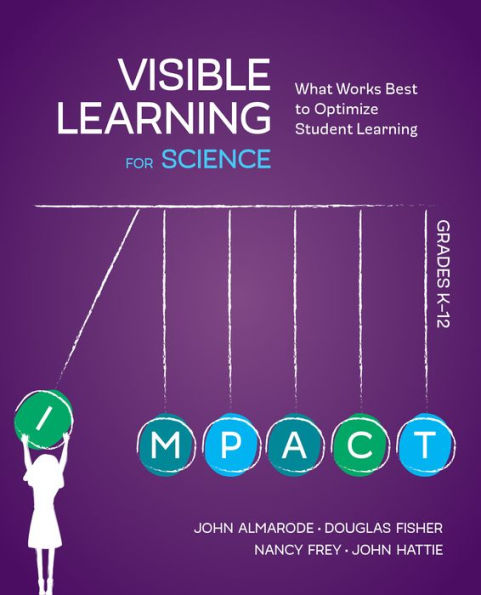
Visible Learning for Science, Grades K-12: What Works Best to Optimize Student Learning
216
Visible Learning for Science, Grades K-12: What Works Best to Optimize Student Learning
216eBook
Available on Compatible NOOK devices, the free NOOK App and in My Digital Library.
Related collections and offers
Overview
In Visible Learning for Science, the authors reveal that it’s not which strategy, but when, and plot a vital K-12 framework for choosing the right approach at the right time, depending on where students are within the three phases of learning: surface, deep, and transfer.
Synthesizing state-of-the-art science instruction and assessment with over fifteen years of John Hattie’s cornerstone educational research, this framework for maximum learning spans the range of topics in the life and physical sciences. Employing classroom examples from all grade levels, the authors empower teachers to plan, develop, and implement high-impact instruction for each phase of the learning cycle:
Surface learning: when, through precise approaches, students explore science concepts and skills that give way to a deeper exploration of scientific inquiry.
Deep learning: when students engage with data and evidence to uncover relationships between concepts—students think metacognitively, and use knowledge to plan, investigate, and articulate generalizations about scientific connections.
Transfer learning: when students apply knowledge of scientific principles, processes, and relationships to novel contexts, and are able to discern and innovate to solve complex problems.
Visible Learning for Science opens the door to maximum-impact science teaching, so that students demonstrate more than a year’s worth of learning for a year spent in school.

Product Details
| ISBN-13: | 9781506394190 |
|---|---|
| Publisher: | SAGE Publications |
| Publication date: | 02/15/2018 |
| Sold by: | Barnes & Noble |
| Format: | eBook |
| Pages: | 216 |
| File size: | 6 MB |
About the Author
Continuing his collaborative work with colleagues on what works best in teaching and learning, How Tutoring Works, Visible Learning in Early Childhood, and How Learning Works, all with Corwin Press, were released in 2021.
Douglas Fisher is professor and chair of educational leadership at San Diego State University and a leader at Health Sciences High and Middle College. Previously, Doug was an early intervention teacher and elementary school educator. He is a credentialed teacher and leader in California. In 2022, he was inducted into the Reading Hall of Fame by the Literacy Research Association. He has published widely on literacy, quality instruction, and assessment, as well as books such as Welcome to Teaching, PLC+, Teaching Students to Drive their Learning, and Student Assessment: Better Evidence, Better Decisions, Better Learning.
Nancy Frey is professor of educational leadership at San Diego State University and a leader at Health Sciences High and Middle College. Previously, Nancy was a teacher, academic coach, and central office resource coordinator in Florida. She is a credentialed special educator, reading specialist, and administrator in California. She is a member of the International Literacy Association’s Literacy Research Panel. She has published widely on literacy, quality instruction, and assessment, as well as books such as The Artificial Intelligences Playbook, How Scaffolding Works, How Teams Work, and The Vocabulary Playbook.
John Hattie, PhD, is an award-winning education researcher and best-selling author with nearly thirty years of experience examining what works best in student learning and achievement. His research, better known as Visible Learning, is a culmination of nearly thirty years synthesizing more than 2,100 meta-analyses comprising more than one hundred thousand studies involving over 300 million students around the world. He has presented and keynoted in over three hundred international conferences and has received numerous recognitions for his contributions to education. His notable publications include Visible Learning, Visible Learning for Teachers, Visible Learning and the Science of How We Learn; Visible Learning for Mathematics, Grades K-12; and 10 Mindframes for Visible Learning.
Table of Contents
List of VideosAcknowledgments
About the Authors
Introduction
Chapter 1. Science Learning Made Visible
Visible Learning
Surface, Deep, and Transfer
Challenging Tasks
Science Is More Than Demonstrations and Labs
The Role of Social Skills in Science
Teacher Clarity
Conclusion
Reflection Questions
Chapter 2. Science Surface Learning Made Visible
Surface Learning in Science
Selecting Science Tasks That Promote Surface Learning
Surface Learning in Science Made Visible
Scientific Processes and Thinking
Feedback
Conclusion
Reflection Questions
Chapter 3. Science Deep Learning Made Visible
Deep Learning in Science
Selecting Science Tasks That Promote Deep Learning
Deep Learning in Science Made Visible
Scientific Processes and Thinking
Feedback
Conclusion
Reflection Questions
Chapter 4. Science Transfer Learning Made Visible
Transfer Learning
Types of Transfer: Near and Far
The Paths for Transfer: Low-Road Hugging and High-Road Bridging
Managing Misconceptions
Conditions Necessary for Transfer Learning
Selecting Science Tasks That Promote Transfer Learning
Helping Students Transform Scientific Understanding
Scientific Processes and Thinking
Feedback
Conclusion
Reflection Questions
Chapter 5. Science Learning Made Visible Through Evaluation
Determining Impact
Calculating the Effect Size
Selecting Evaluations That Promote
Response to Intervention in the Science Classroom
Learning From What Doesn’t Work
Conclusion
Reflection Questions
References
Index
